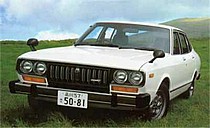
The 810 was introduced in July 1976. Engine options were largely carried over, with all petrol engines offered in Japan meeting the 1976 emissions requirements thanks to Nissan’s NAPS system. Styling was an evolution of the 610s, with slightly squared off features but retaining a slight “coke bottle” shape. No two-door sedan was available, but the four-door sedan, two-door hardtop coupé (SSS Coupé) and five-door station wagon were offered. As usual, the wagon was mainly sold as a “light van” in Japan, meaning that it was engineered with cargo in mind and had a live, leaf-sprung rear axle rather than the independent rear suspension of the saloons and coupés.
In Japan the range gradually received upgraded motors which could pass the 1978 emissions standards; these models carry 811 series chassis numbers. Japanese market 811-series vehicles replaced the Bluebird badge on the rear decklid with a NAPS badge, identifying emission control technology as having been installed. The process of meeting the 1978 standards began in October 1977 and continued until August 1978 and meant replacing the earlier L-series engines with the new crossflow Z engines, based on the L. From March 1979 until the end of production in November that year, the NAPS badge was once again removed from passenger cars (although taxis featured a “NAPS-Z” badge as they were now equipped with the new Z engine).
In Japan there continued to be a six-cylinder version of the Bluebird available. As before, this received a longer wheelbase and nose, while retaining the rear end of the regular Bluebird range. The Bluebird G6 used a carburetor for the base model and fuel injection for the sporty version. The 2.0 L engine was good for 115 or 130 PS (85 or 96 kW) JIS depending on fuel feed. In August 1978 the Bluebird G4 was introduced (PD811), a 1.8-litre four-cylinder model fitted with the long-nose bodywork.
Europe (160B/180B)
At this time, with several UK auto-producers such as British Leyland losing market share, Datsun had grabbed the headlines as the UK’s leading car importer. The magazine Autocar road tested a 180B Bluebird and recorded a top speed of 101 mph (163 km/h) along with a 0–60 mph (0 – 97 km/h) time of 13.6 seconds. The Datsun’s overall fuel consumption for the test was 27.7 mpg (10.2 L/100 km). For all three of these performance measurements, it was marginally better than the Ford Cortina 1600 GL which continued to dominate this sector in the UK, but both cars were beaten for speed and acceleration (though not for fuel economy) by the relatively crude Morris Marina 1.8HL. It was probably more significant that the Bluebird had a manufacturer’s recommended retail price, including sales taxes, of £2950 as against £3263 for the Ford and £3315 for the Morris. The testers found the car matched the competition in most respects, though the brakes were criticised for being “not up to current standards”.
In Europe, the 160B claimed 81 PS (60 kW), while the larger-engined 180B had 88 PS (65 kW) to offer. The sporting SSS model had to make do with a very modest power increase; two more horsepower for 90 PS (66 kW).
Australia (200B)
Introduced in October 1977 in Australia, the first 200Bs were all fully imported in sedan, station wagon and coupe forms, the latter retaining the SSS badge. In January 1978 local assembly began for the sedan, followed shortly by the wagon. The sedan trim levels were GL and GX. While the coupe remained a hardtop, Datsun added an opera window in the rear pillar. The coupe was discontinued in Australia in 1979. The engine used is a larger version of the L series engine from the preceding 180B. Dubbed the L20B its capacity was increased to 1952 cc, making it good for 72 kW (97 hp).
Almost immediately the 200B became Australia’s top selling four-cylinder car, a position it held until it was displaced by the Mitsubishi Sigma. Its popularity however remained strong right through the production run, family buyers appreciative of the plentiful interior room and standard features. It may have been somewhat conservatively styled, but the effort Nissan had put into the engineering of the car made it reliable and tough, qualities most Australians rated higher than a more advanced design.
Only the early fully imported 200B sedans and coupés retained the independent rear suspension from the 180B, locally assembled 200B sedans instead switched to coil springs with a live axle, while the wagon (imported from Japan) had a live axle in the rear with leaf springs. Seen as a giant step backwards, the reason for the change was certainly not a cost-cutting measure, but simply the need for Nissan to reach an 85% local content quota that the then Federal Government demanded of Australian car manufacturers. However, in practice the live rear axle, being an Australian development, proved to actually benefit the car’s overall handling dynamics.
The 2-litre overhead cam engine could be loud at high revs, and there were drive line vibration issues. A correction programme was instituted by the parent company in Japan.
A sportier version of the 200B sedan was released in June 1978. The new SX featured a revised grille, front spoiler, alloy wheels, revised door and seat trim (striped seat inserts) and tachometer, while the suspension was altered to improve handling. The colours available for this model were simply blue, white or red, and the only transmission available was a 4-speed floor shift. Significantly the SX was a unique model to Australia, the added input from Nissan’s Australian design engineers signified a step away from just assembling cars. This in turn led to the locally built Datsuns, and later Nissans, being re-engineered to better suit Australian conditions, with many components being sourced locally a tradition that would continue right up until 1992, when Nissan ceased local manufacture.
In October 1979, the 200B was revised with a new grille, bumpers, seats, trim, and dashboard. The seats were a unique Australian design for the locally built cars. This facelift was penned by Paul Beranger, a former Holden designer – years later he would style the 2006 Toyota Aurion.
In 1980, a limited edition 200B Aspen GL sedan was released featuring distinctive shadow tone paint available in green, blue, or grey. The 200B was discontinued in May 1981, replaced by the Datsun Bluebird. Australian comedy band, Tripod, have written a song about the 200B, called “200B.”
New Zealand (160B/180B/200B)
This model was also released to New Zealand in 1977, assembled CKD in 4-door sedan and 5-door wagon forms. A coupe model was also released, imported built-up from Japan. Unlike the Australian models the sedans used the independent rear suspension system of the Japanese specification models. This Bluebird was the first to be assembled in Nissan New Zealand’s own brand-new assembly plant at Wiri, South Auckland. For the first two years of assembly the cars were fitted with a 1.8-litre unit, hence they used the 180B nameplate. Automatic transmission was optional for both. Nissan also added its first luxury ZX version with this generation – features included velour upholstery, ‘luxury’ cut-pile carpet sourced locally and tinted glass. There was also, for the first time in Kiwi assembly, a wagon variant with mid-range trim and equipment.
North America (810)
1977 Datsun 810 wagon
In North America, Datsun marketed the 810 series Bluebird sold as the Datsun 810 from February 1977 to 1980—the direct ancestor of the long running Datsun/Nissan Maxima range. The Datsun 810 model line began with the six-cylinder Nissan Bluebird 2000G6 sold in Japan. With a longer nose than the regular Bluebird, to accommodate a longer inline-six engine, it was powered by two versions of the SOHC L-series I6 engine: a 2.0 L displacement for the Japanese market and the 2.4-liter L24E unit for the US market. The bigger American engine could reach 125 hp (93 kW) SAE. The Sport version channeled power through a four-speed manual transmission for the sedan and wagon, five-speed transmission for the coupe. These cars were rear-wheel drive and had a semi-trailing arm rear suspension. The six-cylinder station wagon variant, only sold in North America, had a rear live axle to handle extra weight. Some fuel-injected versions had automatic transmissions. The two-door coupé version was introduced in North America in January 1979 for the 1979 model year. Around the same time, the 810 received an exterior refresh. The coupé version was never available in second generation 810/Maximas.
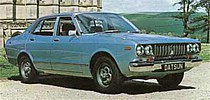
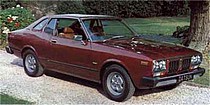
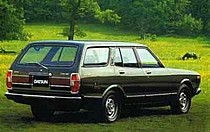
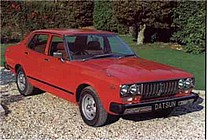
Also called Datsun 160B, Datsun 180B, Datsun 200B, Datsun 810
Chassis Codes 810, P810, PL810, WP80, NJ810, WNJ810
Assembly Japan: Oppama Plant, Yokosuka, Kanagawa, Australia: Clayton, Victoria
Body style 4-door saloon/sedan,2-door coupé, 5-door wagon/van
Layout FR layout
Engine
1595 cc L16 I4
1595 cc Z16 I4
1770 cc L18/L18E I4
1770 cc Z18/Z18E I4
1952 cc L20B I4
1998 cc L20/L20E I6
2393 cc L24/L24E I6
Transmission 4/5-speed manual, 3-speed automatic
Dimensions
Wheelbase
2,500 mm (98.4 in)
2,650 mm (104.3 in) (G4/G6)
Length 4,260 mm (167.7 in)
Width 1,631 mm (64.2 in)
Height 1,389 mm (54.7 in)
Curb weight 1,084 kg (2,390 lb)
![]()